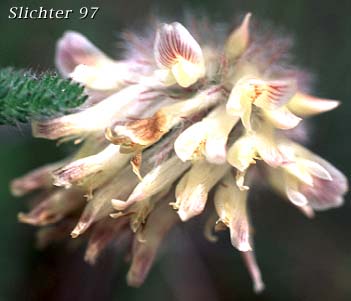
Woolly-head clover is an attractive perennial found in the Pacific Northwest. It has a thick taproot with several to many stem 20-60 cm tall. The herbage is sparsely to thickly pubescent. The 3 leaflets of variety eriocephalum are elliptic-oblong to ovate and range in length from 1 to 4 cm.
The 3 leaflets of variety piperi are each elliptic to oblong, and somewhat rounded at the tips. They may be 2 to 7 cm long. The stipules are ovate to lanceolate, ranging from 2 to 5 cm long.
The 3 leaflets of variety cusickii are linear and sharply pointed at both ends, with serate margins. They range from 3.5 to 7.5 cm long and 2.5 to 7 mm wide.
The flower heads oval to rounded, from 2.5 to 3.0 cm wide, and borne on stems that typically exceed the height of the leaves. The flower head consists of 25-80 individual flowers which are pinkish to red. Individual flowers are 12-17 mm long and strongly reflexed or bent downward.
Woolly-head clover is a plant of dry meadows and woods.
Woolly-head clover is found on both sides of the Cascades from south-central Washington eastward to west-central Idaho and then south through Oregon to northern California and south-central Utah. Variety eriocephalum is found from Klickitat County, Washington south to northern California.